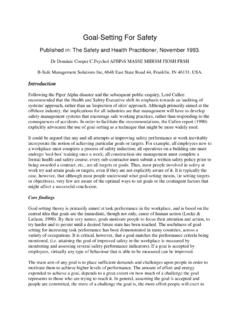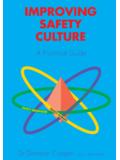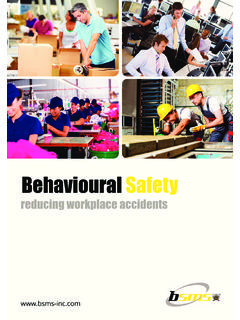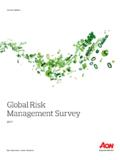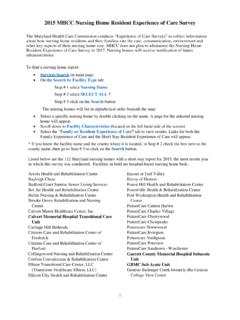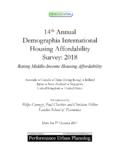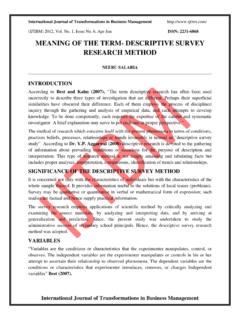Transcription of Practicalities of conducting a safety climate survey …
1 The Measurement & Monitoring of safety Performance Conference, IIR Ltd, The Marriot Hotel, Regents Park, London W1, 12-13th Oct 1998. Practicalities of conducting a safety climate survey to measure your employee's current attitudes and perceptions towards safety Dr Dominic Cooper AFBPsS CFIOSH RSP. 1. Introduction A good safety climate is characterised by a collective commitment and concern, whereby all employees share similar positive perceptions about organisational safety features. An organisations prevailing safety climate serves as a frame of reference that shapes the safety -related attitudes and behaviours of its employees. In turn, this influences the outcomes of the organisation's safety improvement initiatives. Because people's perceptions of safety , affect and determine their daily safety -related behaviours, it makes sense to identify employees positive and negative perceptions of the organisations safety management system.
2 This is normally achieved by conducting safety climate surveys that focus upon particular organisational characteristics thought to be important to the organisation's management of safety . In this way, deficiencies in the way safety is currently operationalised in an organisation can be identified, so that the appropriate remedial actions can be taken. 2. Overcoming employee's resistance to taking part in the survey It must be stated that, in the authors' experience the overwhelming majority of employees welcome the opportunity to express their views about the effectiveness of their organisations current safety management system. However, a minority of employees tends to be resistant to the process, partly because: of suspicious about the organisation's intentions;. personnel are required to complete the questionnaire in their own time.
3 The survey is seen as a waste of time, because the organisation has not undertaken anyremedial actions for safety issues already identified by other means. Others simply do not wish to take part in any survey whatever its focus. Overcoming resistance can be achieved by: Allowing employees (or their representatives) to help design, administer and analyse the survey , or at least be involved in choosing the key characteristics to be measured;. Providing incentives for completing the survey ( donating a sum of money to a preferred charity for the department with the greatest response rate);. Using an external resource to provide neutrality and expertise. Communications Whichever, option is followed, the company management (preferably the CEO) should write a letter (attached to the survey ) endorsing the survey , which also emphasises that the survey is anonymous, that no attempts will be made to identify individual respondents, and that all those involved will receive feedback about the results at discussion meetings.
4 Indeed, it could 1998 Prof. Dominic Cooper, BSMS Inc, Franklin, IN 46131. Tel/Fax: +1 (317) 736 8980 e-mail: 1. The Measurement & Monitoring of safety Performance Conference, IIR Ltd, The Marriot Hotel, Regents Park, London W1, 12-13th Oct 1998. be argued that communicating the purpose of the survey , how it will be conducted, and what will occur as a result of the survey is the most important technique available for overcoming people's resistance to participating in the survey . Timing the distribution of the survey When to distribute the survey is a further consideration, as resistance caused by other organisational issues may impact on the response rate ( the numbers of people completing the survey questionnaire). The timing is a particularly important issue when: Substantial numbers of employees are on holiday Wage negotiations are not going well Industrial relations problems are being experienced Plant shutdowns are in progress Major changes in an organisation's structure are underway Other surveys ( Quality, Human Resources) have been completed within the previous two months 3.
5 Determining how you can best identify the safety issues of key importance Before starting to develop a safety climate survey , it makes sense to determine the survey 's objectives, how these are going to be achieved, and what use is to be made of the results. Aims & Objectives In most instance companies are interested in identifying safety management system deficiencies that pertain to the whole organisation ( business unit), to each individual department, and in some cases by hierarchical level, gender, age, length of employees service and / or years job experience. These aspects are termed demographics'. If an organisation intends to analyse the resulting data by these organisational aspects, a method for capturing this data will need to be included in the survey at the outset. Thinking through such issues will also help to determine the scope of the survey .
6 In a multi- national, or multi-site company decisions about which business units will take part, need to be made. Once this has been determined, the safety issues of importance to these business units can be determined by: Analysing the company's accident records to highlight particular systems, behaviours, procedures, etc., that have been associated with a large number of historical accidents /. incidents. Undertaking group discussions with employees to identify their main concerns;. In essence the idea is to generate an item bank of statements related to a set of particular topics ( management's commitment to safety ) that capture the important aspects of the topic (usually between 5-10 individual statements per topic). 1998 Prof. Dominic Cooper, BSMS Inc, Franklin, IN 46131. Tel/Fax: +1 (317) 736 8980 e-mail: 2.
7 The Measurement & Monitoring of safety Performance Conference, IIR Ltd, The Marriot Hotel, Regents Park, London W1, 12-13th Oct 1998. Alternatively, it is possible to make use of propriety computerised safety climate measures such as the HSE safety climate Tool (HSE, 1997) or The B-Safe Computerised safety climate survey (1998). The advantage is that these contain pre-prepared questions that have been extensively researched, the analyses of responses are simplified, and they are available for immediate use. After a decade of safety climate research (conducted by the author and colleagues in construction, manufacturing and local government, and by the author in the chemicals, foods, & paper industries) the following eleven dimensions have been shown to provide the main focus for ascertaining an organisation's current safety climate .
8 Each of these is clearly related to an effective safety culture. 1] Management Commitment 2] Management Actions 3] Personal commitment to safety 4] Perceived risk levels 5] The effects of the required work pace 6] Beliefs about accident causation 7] The effects of job induced stress 8] The effectiveness of safety communications within the organisation 9] The effectiveness of emergency procedures 10] The importance of safety training 11] The status of safety people & safety committees within an organisation Contextual features also known to affect safety climate include: 13] The effectiveness of Standard Operating Procedures 14] Responses to Breaches of Standard Operating Procedures (SOP's);. 15] Housekeeping 16] Job Design Changes related to Multi-Skilling 17] Job Design Changes related to Manual Handling 18] Role Ambiguity in light of Organisational Changes 19] Perceptions about working under adverse market conditions 20] The effects of reductions in manning levels 21] Personnel's commitment to the organisation 22] The Effects of Quality Issues on safety 23] Permit to Work Systems 24] Accident / near-miss reporting systems These contextual features can exert important influences on the development of a safety culture /.
9 climate . In a sense these contextual features provide a pick and mix menu, for organisations to consider when they conduct a safety survey , depending on the prevailing circumstance that the organisations finds itself in. It is also a good idea to allow respondents to record their own specific views by including a few ( 4) open-ended questions at the end of the questionnaire. These might ask questions like What are the most important factors adversely affecting your safety ? In this way respondents provide detailed information about specific safety issues affecting them. 1998 Prof. Dominic Cooper, BSMS Inc, Franklin, IN 46131. Tel/Fax: +1 (317) 736 8980 e-mail: 3. The Measurement & Monitoring of safety Performance Conference, IIR Ltd, The Marriot Hotel, Regents Park, London W1, 12-13th Oct 1998.
10 4. Keeping the survey manageable Respondents completion time It is important that the survey does not take too long to complete. The average time should not exceed 25-30 minutes. This normally requires that the numbers of statements people are asked to rate be kept to a maximum of 100. Conversely, surveys with less than 50-60 statements tend to be quite superficial and miss important aspects of safety . Likewise for ease of understanding the statements should be written in such a way that they are: Short - not much longer than fifteen words Simple - focused on only one complete thought Familiar - using everyday language Providing specific instructions about how a person's response to an item statement should be recorded can also help reduce completion time, as it reduces ambiguity and uncertainty.
